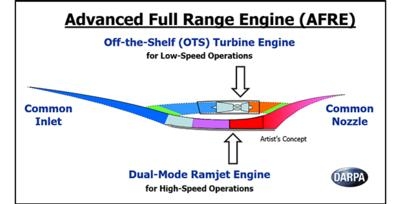DARPA Advanced Full Range Engine Research Paving The Way To Routine, Reusable Hypersonic Flight
In the decades-long quest to develop reusable aircraft that can reach hypersonic speeds—Mach 5 (approximately 3,300 miles per hour) and above—engineers have grappled with two intertwined, seemingly intractable challenges: The top speed of traditional jet-turbine engines maxes out at roughly Mach 2.5, while hypersonic engines such as scramjets cannot provide effective thrust at speeds much below Mach 3.5. This gap in capability means that any air-breathing hypersonic vehicles developed today would use disposable rockets for one-time boosts up to operating speed, limiting the vehicles’ usefulness.

To help remove these constraints and lay the framework for routine hypersonic flight with reusable vehicles, DARPA has launched its Advanced Full Range Engine (AFRE) program. AFRE seeks to develop and demonstrate a new aircraft propulsion system that could operate over the full range of speeds required from low-speed takeoff through hypersonic flight.
“Instead of designing an entirely new kind of engine, we’re envisioning an inventive hybrid system that would combine and improve upon the best of off-the-shelf turbine and ramjet/scramjet technologies,” said Christopher Clay, DARPA program manager. “This won’t be the first time that ambitious engineers will attempt to combine turbine and ramjet technologies. But with recent advances in manufacturing methods, modeling, and other disciplines, we believe this potentially groundbreaking achievement may finally be within reach.”
AFRE aims to explore a turbine-based combined cycle (TBCC) engine concept, which would use a turbine engine for low-speed operations and a dual-mode ramjet—which would work efficiently whether the air flowing through it is subsonic (as in a ramjet) or supersonic (as in a scramjet)—for high-speed operations. The two components of the hybrid engine would share a common forward-facing air intake and rear-facing exhaust nozzle to release thrust.
AFRE aims to develop critical technologies and culminate in ground-based testing of a full-scale, integrated technology demonstration system. If that testing is successful, further development of the AFRE technology would require flight testing in a potential follow-on demonstration program.
Systems that operate at hypersonic speeds offer the potential for military operations from longer ranges with shorter response times and enhanced effectiveness compared to current military systems. Such systems could provide significant payoff for future U.S. operations, particularly as adversaries’ capabilities advance.
To familiarize potential participants with the technical objectives of AFRE, DARPA has scheduled a Proposers Day in advance of a planned Broad Agency Announcement (BAA). The Proposers Day will be held on Wednesday and Thursday, July 13 and 14, 2016 at the DARPA Conference Center in Arlington, Va. The event will run from 1:00 PM to 5:00 PM Eastern on July 13 and from 9:00 AM to 12:00 PM Eastern on July 14.
(Image provided with DARPA news release. DARPA’s new Advanced Full Range Engine (AFRE) program seeks to develop and demonstrate a new aircraft propulsion system that could operate at subsonic through hypersonic speeds and lay the framework for routine, reusable hypersonic flight)
 Unfortunate... ANN/SportPlane Resource Guide Adds To Cautionary Advisories
Unfortunate... ANN/SportPlane Resource Guide Adds To Cautionary Advisories ANN FAQ: Turn On Post Notifications
ANN FAQ: Turn On Post Notifications ANN's Daily Aero-Term (04.29.24): Visual Approach Slope Indicator (VASI)
ANN's Daily Aero-Term (04.29.24): Visual Approach Slope Indicator (VASI) ANN's Daily Aero-Term (04.28.24): Airport Marking Aids
ANN's Daily Aero-Term (04.28.24): Airport Marking Aids ANN's Daily Aero-Linx (04.28.24)
ANN's Daily Aero-Linx (04.28.24)



